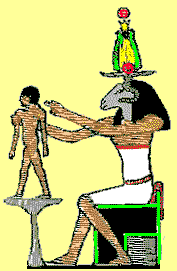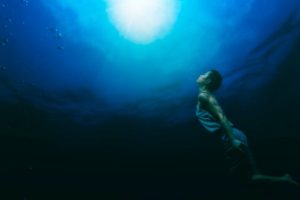Becoming: Feet of Clay
Genesis 2 says that God created Adam out of the dust of the earth. World myths (Greek, Sumerian, Egyptian, Chinese, Babylonian, Hindu, Maori, Inca, etc.) depict people, male and/or female made from clay. Even Wonder Woman was sculpted out of clay by her mother Hyppolita! A Jewish Talmudic legend portrays Adam as a golem (clay figure–a body without a soul) for the first 12 hours of his existence.

It is safe to say that we all have proverbial “feet of clay” even before we left the Garden of Eden. If we were already clay or dust were we of heaven or of earth?
A long time ago I surmised that the reason we Earth beings left the Garden of Eden was because the divine actually wanted us to go—a reason and a purpose. Perhaps we had developed enough that it was time; or perhaps we hadn’t developed enough and needed a challenge course for growth.
So, as the Genesis 2& 3 goes, an apple tree was planted in the midst of other fruit trees in Eden and the young’uns were told you can eat the fruit of any tree except the fruit of the tree of knowledge. As any parent knows, if you put something where the child will regularly encounter it and then say, “don’t touch”, the temptation is irresistible. But even then Adam and Eve didn’t eat the fruit, so a serpent had to be devised to seduce them. And, voila! Success! Humans who lived in an eternal state of BEING fell into BECOMING. Birth, biography, death.
“What could you not accept, if you but knew that everything that happens, all events, past, present and to come, are gently planned by One Whose only purpose is your good?”
A Course in Miracles
Not knowing its source, I kept that quote on my refrigerator for years so that I would see it often. And, because I am aware that BEING is “One”, I concluded that I was an integral part of the planning.
“Is willing to accept that she creates her own reality except for some of the parts where she can’t help but wonder what the hell she was thinking.”
Story People, Almost New Age
Is our world is a virtual reality of our own design? This idea is closely aligned with the ancient spiritual tradition of India that we are living in “maya” (roughly translated as “illusion”). There is the beautiful maya of the natural world that is there to appreciate it and to meditate on its many mysteries, to teach us and help us grow spiritually. But it is the human maya that becomes our role play—our charade–and leads us into believing that this Earth life is our only true identity. However, it is not. It is a merely temporary reality.
: “Reality is an illusion, albeit a very persistent one.”
Albert Einstein
Any cursory exploration of quantum mechanics reveals that modern Western science has met ancient Eastern tradition.
Wordsworth captured this knowledge and the inevitable destiny of ego development in Ode on Intimations of Immortality. An excerpt:
Our birth is but a sleep and a forgetting;
The Soul that rises with us, our life’s Star,
Hath had elsewhere its setting
And cometh from afar;
Not in entire forgetfulness,
And not in utter nakedness,
But trailing clouds of glory do we come
From God, who is our home:
Heaven lies about us in our infancy!
Shades of the prison-house begin to close
Upon the growing Boy,
But he beholds the light, and whence it flows,
He sees it in his joy;
The Youth, who daily farther from the east
Must travel, still is Nature’s priest,
And by the vision splendid
Is on his way attended;
At length the Man perceives it die away,
And fade into the light of common day.
 Let us think of the newborn for a moment. In healthy environments this precious being is welcomed with such love and joy. The aroma of the newborn is like a perfume of heaven. It seems to be alight with joy for no apparent reason or distressed by hunger or physical discomfort. Does the newborn know a religion? …a nationality? … its age? And, although it is no doubt affected somewhat by gender, does it know it has one? Does it know it has a name or even an identity? I would say, no, it does not. It is a Self. In it is the seed of its becoming. It has gifts, challenges and expressions inherent to itself and its genetics. Given a nurturing environment these indwelling characteristics will emerge in proper sequence as determined by a majestic natural process.
Let us think of the newborn for a moment. In healthy environments this precious being is welcomed with such love and joy. The aroma of the newborn is like a perfume of heaven. It seems to be alight with joy for no apparent reason or distressed by hunger or physical discomfort. Does the newborn know a religion? …a nationality? … its age? And, although it is no doubt affected somewhat by gender, does it know it has one? Does it know it has a name or even an identity? I would say, no, it does not. It is a Self. In it is the seed of its becoming. It has gifts, challenges and expressions inherent to itself and its genetics. Given a nurturing environment these indwelling characteristics will emerge in proper sequence as determined by a majestic natural process. During one of our group mentoring sessions, the leader, a mystic (former priest and a PhD psychologist) stated that I (Sharon) do not have an ego. The uproar of all the egos in the room arguing that of course I also had an ego was pretty funny. It was probably just a question of semantics because words like ego, identity, self, persona, and awareness are so poorly defined.
During one of our group mentoring sessions, the leader, a mystic (former priest and a PhD psychologist) stated that I (Sharon) do not have an ego. The uproar of all the egos in the room arguing that of course I also had an ego was pretty funny. It was probably just a question of semantics because words like ego, identity, self, persona, and awareness are so poorly defined.